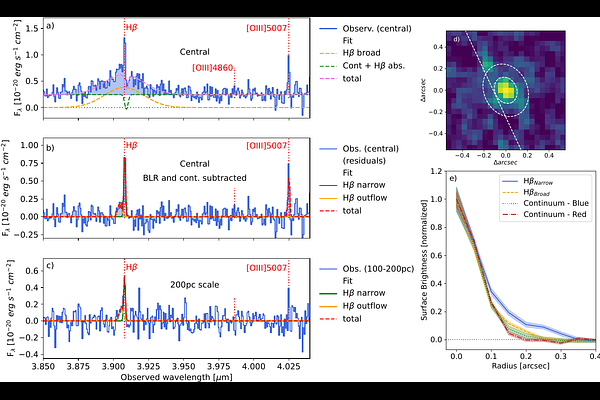A black hole in a near-pristine galaxy 700 million years after the Big Bang

A black hole in a near-pristine galaxy 700 million years after the Big Bang
Roberto Maiolino, Hannah Uebler, Francesco D'Eugenio, Jan Scholtz, Ignas Juodzbalis, Michele Perna, Volker Bromm, Pratika Dayal, Sophie Koudmani, Boyuan Liu, Raffaella Schneider, Debora Sijacki, Rosa Valiante, Alessandro Trinca, Saiyang Zhang, Marta Volonteri, Kohei Inayoshi, Stefano Carniani, Kimihiko Nakajima, Yuki Isobe, Joris Witstok, Gareth C. Jones, Sandro Tacchella, Santiago Arribas, Andrew Bunker, Elisa Cataldi, Stephane Charlot, Giovanni Cresci, Mirko Curti, Andrew C. Fabian, Harley Katz, Nimisha Kumari, Nicolas Laporte, Giovanni Mazzolari, Brant Robertson, Fengwu Sun, Bruno Rodriguez Del Pino, Giacomo Venturi
AbstractThe recent discovery of a large number of massive black holes within the first two billion years after the Big Bang, as well as their peculiar properties, have been largely unexpected based on the extrapolation of the properties of luminous quasars. These findings have prompted the development of several theoretical models for the early formation and growth of black holes, which are, however, difficult to differentiate. We report the metallicity measurement around a gravitationally lensed massive black hole at redshift 7.04, hosted in a galaxy with very low dynamical mass. The weakness of the [OIII]5007 emission line relative to the narrow Hbeta emission indicates an extremely low chemical enrichment, less than 0.01 solar. We argue that such properties cannot be uncommon among accreting black holes around this early cosmic epoch. Explaining such a low chemical enrichment in a system that has developed a massive black hole is challenging for most theories. Models assuming heavy black hole seeds (such as Direct Collapse Black Holes) or super-Eddington accretion scenarios struggle to explain the observations, although they can potentially reproduce the observed properties in rare cases. Models invoking "primordial black holes" (i.e. putative black holes formed shortly after the Big Bang) may potentially explain the low chemical enrichment associated with this black hole.